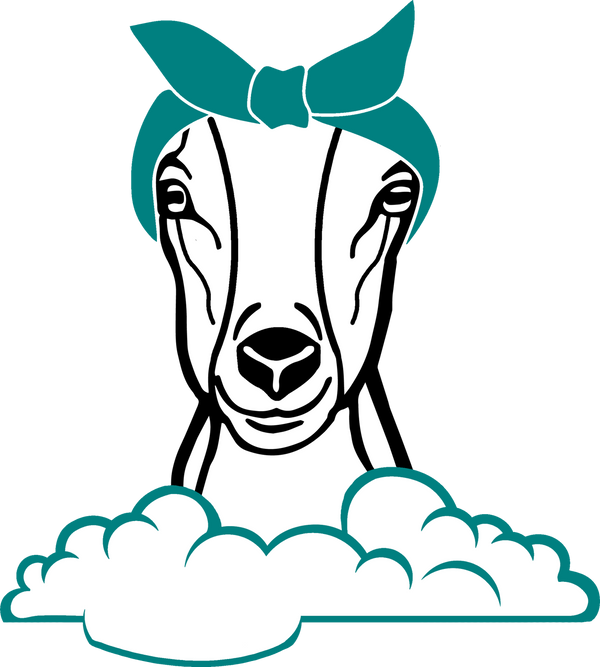The Benefits of Goat Milk Soap | The Goat Milk Soap Store

What are the Benefits of Goats Milk?
Mabel The Goat Scientist ExplainsBenefits of Goats Milk Soap and Lotion: Nourishment, Moisturization and Repair
There are several key factors when assessing the properties and benefits of goats milk when used in products:
Nourishment
Minerals: The mineral Selenium helps to nourish skin and in general, helps to keep skin healthier.
Moisturizaation
Fat content and composition: Fat in goats milk acts as a natural moisturizer.
Molecular structure
Acids content: Help to remove dead skin, allowing the moisturizers to penetrate into the new cells thus using the moisturizers more effectively.
Repair
Vitamin: Vitamin A helps to repair damaged skin Hydroxy Acids: Help to remove dead skin which, also helps to relieve irritation that may be caused by dead skin cells.
Longer Details
Minerals
Milk from goats contains numerous minerals which are thought to be beneficial to overall skin health. One such mineral is Selenium. *Our discussion here will be restricted to Selenium topically applied rather than ingested.
How does Selenium get into our soap?
Selenium is a naturally occuring mineral found in soil, water and in certain types of food. For goats, Selenium is a required mineral which is crucial in the reproductive cycle. Defiencies can lead to kidding problems (birthing) and can cause issues in placenta passage. Selenium also plays a role in internal absorption of other minerals and the protection of cells within a goats body. To this end, it is important that goats obtain the necessay amount of Selenium either through nature browsing or by supplement. When a goat ingests Selenium, it is then absorbed and some is passed into their milk allowing nursing kids to obtain it. (Newborns and young kids initially lack the ability to process solid foods and therefore unable to obtain Selenium through eating solid food. They lack the required rumen (1st stomach) bacteria to properly digest food. Milk from their dam bypasses their first stomach (Rumen) and is directed to their fourth stomach (abomasum) by an esophageal flap, allowing the milk to be digested and utilized for bodily needs.)
To sum it up: A goat ingests Selenium (food or supplement), some is passed into the mothers' milk, we milk the goat and we use this milk to make our soap.
Potential Benefits of Selenium Applied Topically
Selenium is thought to act as an antioxidant and as an anti-inflammatory.
Acts to keep skin generally healthier
Fat
Milk contains fat. This is part of what makes it so good! Goats milk can contain up to 10% fat (a.k.a butterfat or cream). Fat is a natural moisturizer.
Acids Content:
Hydroxy Acids
Goat Milk contains Hydroxy Acids, specifically Lactic Acid. When Lactic Acid is applied to the skin it helps to remove the dead skin cells that are a common cause for irritation. This allows your new skin cells to be at the surface, and the moisturizing benefits to penetrate more easily. Alpha Hydroxy acids are also used to treat extremely dry skin (xerosis), an inherited disease marked by dry, scaly skin (ichthyosis), and a condition that causes darkening of the skin (melasma).
Pantothenic Acid
Pantothenic Acid, is also known as Vitamin B5, d-panthenol or dl-panthenol. It is most noted scientifically for its ability to function as a humectant; a water-binding substance that attracts and retains water. As a humectant, Pantothenic Acid stabilizes your skin barrier functions, reducing the amount of water lost through the skin. By applying a Pantothenic Acid, like what is found in goat milk to the skin, you will not only increase your skin’s hydration, but improve its softness and elasticity. It is ideal for the treatment of dry, scaly or rough skin. When applied to the skin, it offers relief from itchiness and pain and reduces redness. Wounds treated with Pantothenic Acid have resulted in regenerated tissue that is more solid and elastic. Additionally, a 2002 "Journal of Dermatological Treatment" study noted that Pantothenic Acid enhanced the repair of the skin barrier while reducing inflammation. In terms of protecting skin, Pantothenic Acid acts as a barrier, shielding the skin from skin irritation.
Pantothenic Acid is effective in hydrating, soothing, healing, and protecting skin. This makes it an effective ingredient in formulations to alleviate the following conditions: acne, bed sores, minor cuts, diaper rash, contact dermatitis (produced when the skin comes in contact with irritants or allergens), eczema, insect bites, scrapes and sunburn.
Source(s): *WEB MD, *LIVE STRONG, *JOURNAL OF DERMATOLOGICAL TREATMENT, *NUTRITION DATA
Assumptions:
The following discussion will focus on the benefits with several key assumption. The goats milk we speak of is raw unpasturized goats milk. That is to say, the milk has not been heated to an internal temperature sufficient to kill a high majority of the potentially harmful bacteria. All milk sold in the the United States commericial spaces (grocery store, corner stores, convenience stores, etc) has been pasturized to help prevent any potential bacterial borne illnesses. This is a safety mechanism required by the FDA. While this has been institued for the general good of the population, pasturizing is an indiscriminate process, in that, it kills all things--beneficial and potentially harmful. It is a double edge sword. While minimizing the potentials, many of the beneficial elements are also nullified.

